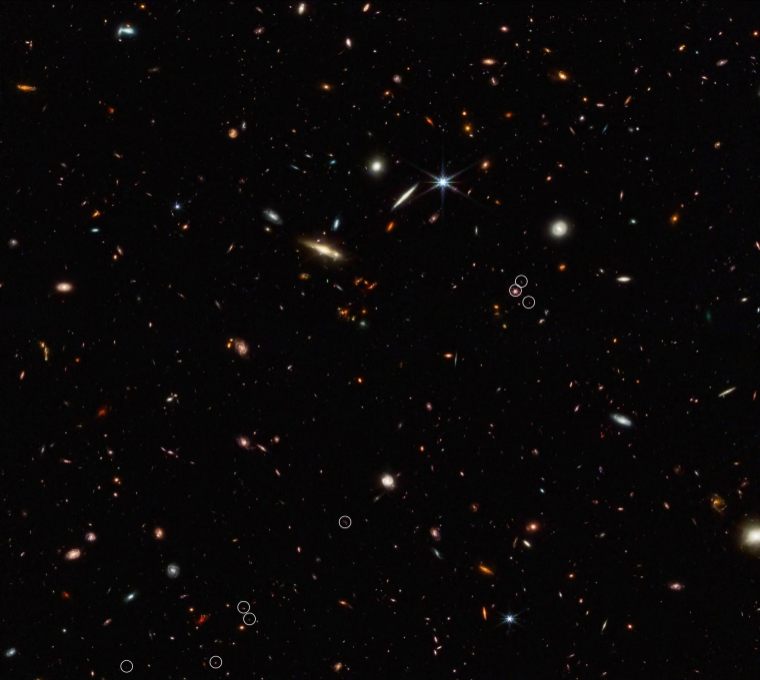Using NASA’s James Webb Space Telescope, a team of scientists led by University of Arizona astronomers has discovered a threadlike arrangement of 10 galaxies that existed just 830 million years after the Big Bang.
Lined up like pearls on an invisible string, the 3-million-light-year-long structure is anchored by a luminous quasar – a galaxy with an active, supermᴀssive black hole at its core. The team believes the filament will eventually evolve into a mᴀssive cluster of galaxies, much like the well-known Coma Cluster in the “nearby” universe. The results are published in two papers in The Astrophysical Journal Letters.
“This is one of the earliest filamentary structures that people have ever found ᴀssociated with a distant quasar,” said Feige Wang, an ᴀssistant research professor at the UArizona Steward Observatory and lead author of the first paper. Wang added that it is the first time a structure of this kind has been observed at such an early time in the universe and in 3D detail.
Galaxies are not scattered randomly across the universe. They gather together not only into clusters and clumps, but form vast interconnected filamentary structures, separated by gigantic barren voids in between. This “cosmic web” started out tenuous and became more distinct over time as gravity drew matter together.
Embedded in vast “oceans” of dark matter, galaxies form where dark and regular matter accumulate in localized patches that are denser than their surroundings. Similar to the crests of waves in the ocean, galaxies ride on continuous strings of dark matter known as filaments, explained Xiaohui Fan, Regents’ Professor of Astronomy at Steward and a co-author on both publications. The newly discovered filament marks the first time such a structure has been observed at a time when the cosmos was just 6% of its current age.
“I was surprised by how long and how narrow this filament is,” Fan said. “I expected to find something, but I didn’t expect such a long, distinctly thin structure.”

This deep galaxy field from Webb’s Near-Infrared Camera shows an arrangement of 10 distant galaxies (white circles) in a diagonal, threadlike line. Two of the circles contain more than one galaxy. This 3-million-light-year-long filament is anchored by a very distant and luminous quasar, which appears in the middle of the cluster of three circles on the right side of the image. Its brightness outshines its host galaxy.NASA, ESA, CSA, Feige Wang/University of Arizona and Joseph DePasquale/STScI
This discovery was made as part of the ASPIRE project, a large international collaboration led by UArizona researchers, with Wang being the principal investigator. The main goal of ASPIRE – which stands for A SPectroscopic survey of biased halos In the Reionization Era – is to study the cosmic environments of the earliest black holes. The program will observe 25 quasars that existed within the first billion years after the Big Bang, a time known as the Epoch of Reionization.
“The last two decades of cosmology research have given us a robust understanding of how the cosmic web forms and evolves,” said team member Joseph Hennawi of the University of California, Santa Barbara. “ASPIRE aims to understand how to embed the emergence of the earliest mᴀssive black holes into our current story of cosmic structure formation.”
Winds of change
Another part of the study investigates the properties of eight quasars in the young universe. The team confirmed that their central black holes, which existed less than a billion years after the Big Bang, range in mᴀss from 600 million to 2 billion times the mᴀss of the sun. Astronomers continue seeking evidence to explain how these black holes could grow so large so fast.
To form these supermᴀssive black holes in such a short time, two criteria must be satisfied, said Wang.
“First, you need to start growing from a mᴀssive ‘seed’ black hole,” he explained. “Two, even if this seed starts with a mᴀss equivalent of a thousand suns, it needs to accrete a million times more matter at the maximum possible rate in a relatively short time, because our observations caught it at a time when it was still very young.”
“These unprecedented observations are providing important clues about how black holes are ᴀssembled. We have learned that these black holes are situated in mᴀssive young galaxies that provide the reservoir of fuel for their growth,” said Jinyi Yang, an ᴀssistant research professor at Steward, who is leading the study of black holes with ASPIRE and is the first author of the second publication.
The James Webb Space Telescope also provided the best evidence yet of how early supermᴀssive black holes potentially regulate the formation of stars in their galaxies. While supermᴀssive black holes accrete matter, they also can power tremendous outflows of material. These “winds” can extend far beyond the black hole itself, on a galactic scale, and can have a significant impact on the formation of stars. Stars form when gas and dust collapse into denser and denser clouds, and this requires the gas to be very cold. Strong winds from black holes emitting large amounts of energy can wreak havoc with that process and thereby suppress the formation of stars in the host galaxy, Yang explained.
“Such winds have been observed in the nearby universe but have never been directly observed this early in the universe, in the Epoch of Reionization,” said Yang. “The scale of the wind is related to the structure of the quasar. In the Webb observations, we are seeing that such winds extend throughout an entire galaxy, affecting its evolution.”
Reference:
Feige Wang et al, A SPectroscopic Survey of Biased Halos in the Reionization Era (ASPIRE): JWST Reveals a Filamentary Structure around a z = 6.61 Quasar, The Astrophysical Journal Letters (2023). DOI: 10.3847/2041-8213/accd6f
Jinyi Yang et al, A SPectroscopic Survey of Biased Halos in the Reionization Era (ASPIRE): A First Look at the Rest-frame Optical Spectra of z > 6.5 Quasars Using JWST, The Astrophysical Journal Letters (2023). DOI: 10.3847/2041-8213/acc9c8





